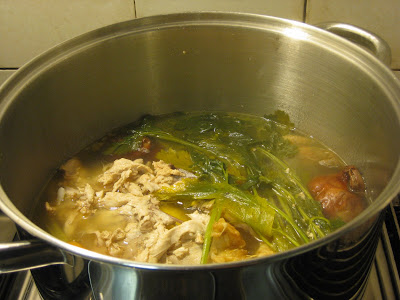“It is on a good stock, or first good broth and sauce, that excellence in cookery depends. If the preparation of this basis of the culinary art is intrusted (sic) to negligent or ignorant persons, and the stock is not well skimmed, indifferent results will be obtained”. From Mrs Beeton’s The Book of Household Management, S. O. Beeton 1861, Chapter V: Soups
Before our time the inability to make a stock would mean a household was denied many dishes unless you were in a position to have staff to make it for you. Oh how I wish I had staff. I dream about having staff.
I’m evidence of the evolution of the self sufficient home chef to supermarket hack. These days I can waltz down to my local supermarket and pick up a whole load of chemical food-like products which can be used in place of stock.
The trouble is the ingredient list looks like this:
Beef Stock Cubes: Wheat flour, salt, yeast extract, maize starch, flavour enhancers (621, 627 ie msg), colour (why?), vegetable oil, autolysed yeast extract, flavourings (including beef flavour – and I bet it wasn’t extracted from a cow...), sugar, onion extract, onion powder.
That’s not food. Not even slightly. What am I doing to my children?
So, despite memories of long hours of simmering and a fatty unappealing result, I thought let’s give this stock caper a go once more.
One night I cooked a roast chicken dinner. After dinner I gathered up the remaining carcass and meat and threw it in a pot of water along with the most wilted vegetables in my fridge. My secret here is that I put all this in my pasta pot which has a built in drainer (handy later believe me).
I simmered this concoction from the time after dinner until just before I went to bed. At that point I drained the stock, threw out the lumpy bits and put the stock into the fridge overnight. The next morning the fat had risen to the top and hardened. I simply scooped this off and voila four litres of chicken stock! Why had I thought it was so hard? The stock went into takeaway containers in the freezer. Easy.
But still I hear you decry this as too hard? Visit your local butcher. Many of ours make their own stock (they have the bones on hand after all). If a stock has more than four ingredients, or ingredients I don’t recognise, I don’t buy it anymore. My great-grandmother wouldn’t have, and now, neither will I.
Oh, and once I had stock on hand, suddenly gravies became so simple, soups easy. Who knew?
Any stock makers out there?
























 The end result? A lovely strong cup of tea. I added the milk after I poured the tea into my cup. I know it is an issue of some contention, but Mrs Beeton didn’t have anything to say about that matter.
The end result? A lovely strong cup of tea. I added the milk after I poured the tea into my cup. I know it is an issue of some contention, but Mrs Beeton didn’t have anything to say about that matter.